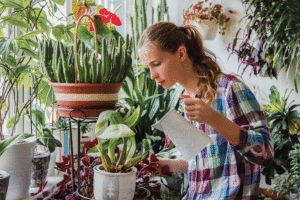
As the soil space in smaller pots starts to be taken over with more and more roots, the result is often problems with water absorption.
Summer is a time of good intentions — but it’s also just too good a time to be either busy exploring or busy being lazy.
If you are headed back from (finally) putting your kids on the bus and notice the sad, root-bound plants left in your mudroom, don’t worry — you can nurture them and send them on their way to flourish too.
As you start to get back in your routine after a long summer, give your potted plants some attention.
Don’t let your plant’s roots be “out of sight, out of mind!”
Roots have a mission to gather water, nutrients and serve as an anchor for the plant, so they grow out and away from the plant.
When they reach the wall of your planter or pot, they go around and around and around.
As the soil space in the smaller pot starts to be taken over with more and more roots, the result is often problems with water absorption.
Therefore, signs of a root bound plant may resemble signs of a plant that is underwatered, like droopiness or yellowing of leaves.
Additionally, a root bound plant will also show signs of being under watered even if it is receiving adequate water.
If you decide to get on the ball by simply moving your root bound plant into a larger pot, unfortunately it’s not that easy — you are going to need to make it up to your neglected plant that became root bound when you were vacation bound.
Start by removing your plant.
Tip the pot over, squeezing the walls to loosen, and gently wiggle the root ball out.
If it’s really stuck and your pot is made of a terra cotta material or another hard container, you can also go along the edges with a knife to loosen it up.
If roots are even growing out of the drainage holes, to remove your plant without tearing even more roots, you’ll want to trim them up carefully with scissors.
After you’ve gotten your plant out, saturate the roots in water for a few minutes.
With it likely not getting adequate water, this long cool drink will help to revive it a bit and help the soil in the new container adhere around the plant more.
If you can lightly shake out some of the old soil without causing damage, do so.
Fill your new, larger container with fresh soil and center your plant in the middle, followed by a moderate watering.
Did you know that even an outdoor plant can become root bound?
That small shrub near your house could now be hitting against the foundation of your home, roots could be hitting an underground pipe, or hey, even a buried treasure chest (wishful thinking).
But in all seriousness, in older properties, when you plant your plant a foot down you may not know there are obstructions that the roots will hit as they go a foot or two down.
The same revival process will work for them too.
Dig an area slightly larger and deeper than you think your plant is growing. You might need to use some teamwork to make the dream work if your plant is large in size.
You can still loosen the soil and give it a good soak in a large bucket, wheelbarrow, kiddie pool etc., then transplant to an area clearer from obstruction.
Another option for some flowers and the like are to divide and plant in an additional area if they are spreading enough to start hitting a wall or fence.
For a large potted or container plant that will be living in it’s pot and not moving to another size up, consider root pruning in the spring.
While most folks think of pruning pertains to the foliage of their plant, what’s underneath counts too.
Trimming up the roots one-third of the total length as well as switching out soil or compost will help keep long term potted plants healthy and absorbing nutrients.



